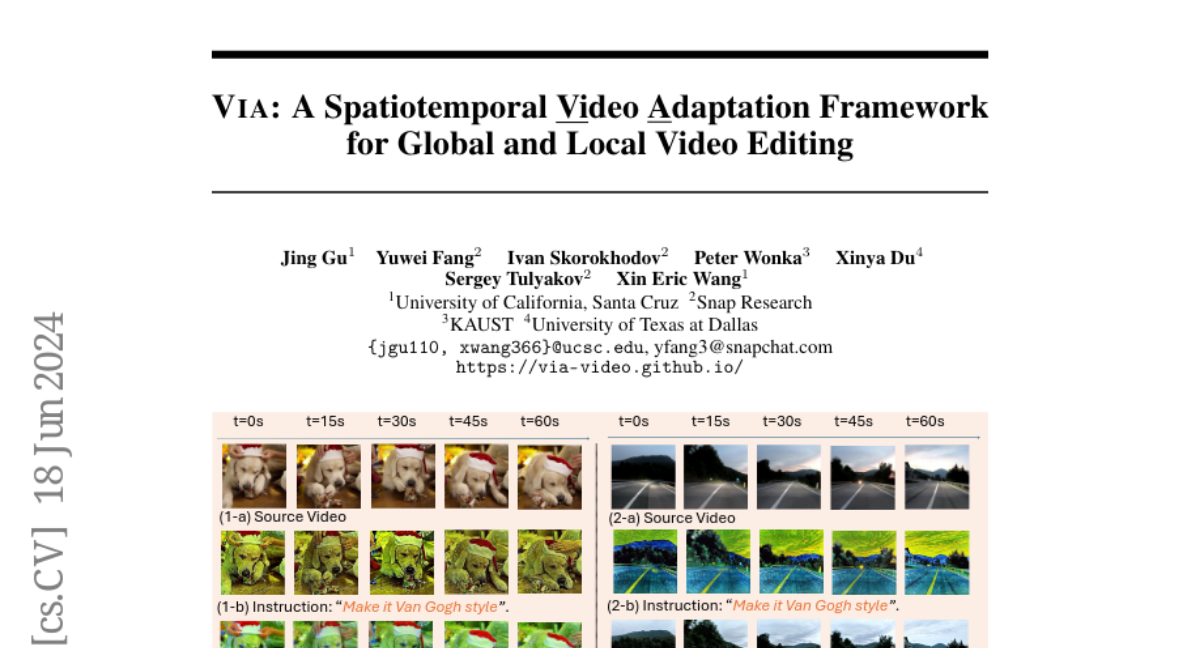VIA: A Spatiotemporal Video Adaptation Framework for Global and Local Video Editing
Jing Gu, Yuwei Fang, Ivan Skorokhodov, Peter Wonka, Xinya Du, Sergey Tulyakov, Xin Eric Wang
2024-06-19

Summary
This paper introduces VIA, a new framework designed to improve video editing by ensuring that edits are consistent both within individual frames and across entire video sequences. It aims to make video editing more accurate and efficient, especially for longer videos.
What's the problem?
Video editing is essential in many fields, but existing methods often fail to understand the overall context of a video and the details within each frame. This can lead to mistakes and inconsistencies in the final edited product, particularly when working with longer videos. For example, transitions between scenes may not flow well, or specific edits may not match the intended style or instruction.
What's the solution?
To solve these issues, the authors developed VIA, which uses two main techniques. First, it employs a test-time editing adaptation method that fine-tunes a pre-trained image editing model to ensure that edits match the given instructions closely and maintain consistency within each frame. Second, it introduces spatiotemporal adaptation, which helps maintain a consistent look and feel across the entire video by applying similar editing effects to key frames and spreading those effects throughout the sequence. This approach allows for precise control over local edits while keeping the overall video coherent.
Why it matters?
This research is important because it enhances how we edit videos, making it easier to create high-quality content quickly and efficiently. By improving both local and global consistency in video edits, VIA could benefit various applications in entertainment, education, and professional communication. This means that creators can produce better videos in less time, ultimately leading to more engaging and polished content.
Abstract
Video editing stands as a cornerstone of digital media, from entertainment and education to professional communication. However, previous methods often overlook the necessity of comprehensively understanding both global and local contexts, leading to inaccurate and inconsistency edits in the spatiotemporal dimension, especially for long videos. In this paper, we introduce VIA, a unified spatiotemporal VIdeo Adaptation framework for global and local video editing, pushing the limits of consistently editing minute-long videos. First, to ensure local consistency within individual frames, the foundation of VIA is a novel test-time editing adaptation method, which adapts a pre-trained image editing model for improving consistency between potential editing directions and the text instruction, and adapts masked latent variables for precise local control. Furthermore, to maintain global consistency over the video sequence, we introduce spatiotemporal adaptation that adapts consistent attention variables in key frames and strategically applies them across the whole sequence to realize the editing effects. Extensive experiments demonstrate that, compared to baseline methods, our VIA approach produces edits that are more faithful to the source videos, more coherent in the spatiotemporal context, and more precise in local control. More importantly, we show that VIA can achieve consistent long video editing in minutes, unlocking the potentials for advanced video editing tasks over long video sequences.